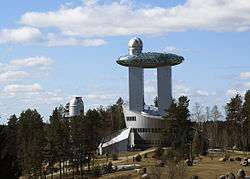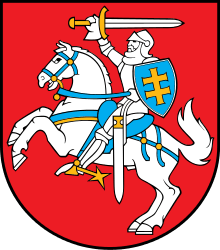Tourism in Lithuania
Lithuania attracts many tourists from neighbouring countries and all over the world. In 2016, 1.5 million tourists arrived to Lithuania.
.jpg)
Overview
Lithuania experiences a constant increase of foreign visitors. As of the first half of 2006 the number of visitors (except from the member states of the European Union and member states of EFTA) has risen 11.1 percent compared to 2005 and reached 985,700. Lithuania attracts foreign visitors mostly from Russia, Germany, Poland, Latvia, Belarus, the United Kingdom, Estonia and Finland. Druskininkai and Birštonas resorts experienced around 50 percent increase of occupiers in 2005 compared to 2004; while the increase of arrivals staying in Neringa and Palanga averaged 22 percent. The majority of visitors staying in hotels and lodging houses come from Germany, Poland, Latvia, the United Kingdom, Russia, and Finland.
From January to September 2006, Lithuanian hotels have experienced a 13.7 percent increase of occupiers compared to 2005, 51 percent of them being foreign visitors (nearly 620,000). Among them, a number of foreign occupiers in Druskininkai has increased 25.7 percent and 27.5 percent in Palanga. Almost a half of the foreign visitors were staying in the capital, Vilnius, that experienced an increase of 10.6 percent. More than twice as many foreigners had stayed in Birštonas' sanatories, compared to 2005.
In 2013, 2.2 million tourists, of whom 1.2 million were from other countries, stayed at various accommodations in Lithuania.[1] This represented an increase of 10.5 percent from 2012.[1]

Agrotourism has also gained extreme popularity in the country among the locals as well as foreigners. Ecotourism is actively promoted by the government and national parks – Lithuania has built a successful ecotourism industry, and is also been acknowledged as one of the world's most ethical destinations.
Hot air ballooning is very popular in Lithuania, especially in Vilnius and Trakai. Theme routes through historical and nature sites are popular among domestic and international tourists.
Nemunas Delta Regional Park and Žuvintas biosphere reserve are known for birdwatching.[2]
Tourism information centres operating in all majors cities and smaller towns, national parks and other places, attractive for domestic or international tourism.[3]
If the nature of the tour is that the guide is "interpreting the cultural and natural heritage of an area", Lithuania requires the guide have a guiding license. This definition follows the European standard for tour guiding (CEN). Licensed Tourist Guides are the only professionals permitted to conduct tours in all sites and museums within a city. Licensed guides are required in those areas where the local authorities state that one of them is mandatory.[4] There is a Guides Database to find a guide in your language as well.[5]
Arrivals by country
Most visitors arriving to Lithuania on short term basis in are from the following countries of nationality:[6][7]
| Rank | Country | 2015 | 2016 |
|---|---|---|---|
| 1 | Germany | 170,100 | 174,800 |
| 2 | Belarus | 163,500 | 171,900 |
| 3 | Russia | 149,700 | 150,600 |
| 4 | Poland | 127,200 | 148,400 |
| 5 | Latvia | 116,600 | 134,500 |
| 6 | Ukraine | 59,500 | 84,000 |
| 7 | Estonia | 52,600 | 58,300 |
| 8 | United Kingdom | 54,100 | 58,200 |
| 9 | Italy | 40,600 | 39,900 |
| 10 | Norway | 42,400 | 39,800 |
| Total foreign | 1,141,800 | 1,258,100 |
Major cities
- Vilnius – capital of Lithuania, first mentioned in Letters of Gediminas in 1323. Vilnius is full of cultural events – new operas, classical music, festivals. Vilnius Events
- Kaunas – temporary interbellum capital of Lithuania with prominent functionalism architecture, art and history museums, largest city Oak Park in Europe.
- Klaipėda – sea port with an attractive old town, Lithuanian Sea Museum[8] and Dolphinarium.[9]
- Panevėžys – capital of Aukštaitija
- Šiauliai – famous for nearby Hill of Crosses
- Kėdainiai – city in central Lithuania with prominent Renaissance architecture monuments
National parks
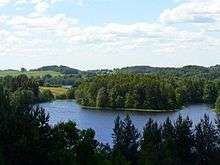
Protected areas established for the preservation of natural and cultural features.
- Aukštaitija National Park
- Žemaitija National Park
- Kuršių Nerija National Park
- Dzūkija National Park
- Trakai Historical National Park
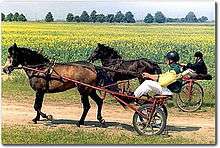
UNESCO World Heritage Sites
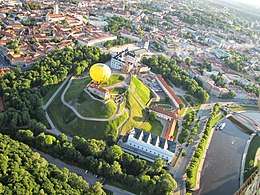
- Kernavė – ancient capital of Lithuania, a complex of historical hillforts and an archeological site, called "Troy of Lithuania"
- Curonian Spit – the resort and nature reserve.
- Vilnius Old Town – the old capital of the Grand Duchy of Lithuania, is among the largest historical centres in Europe.
Resorts

Seaside resorts
- Palanga – the summer capital of Lithuania with sandy beaches
- Nida – a world heritage site with unique nature
- Juodkrantė – a resort in Neringa
Spa towns
- Birštonas – a balneological resort and a spa town, surrounded by pine forests.
- Druskininkai – a developed spa town with the largest water park in the Eastern Europe, the Snow Arena – one of the biggest indoor skiing slopes in Europe. The Water Park and the Snow Arena connected with the cable car.[11]
Pilgrimage sites
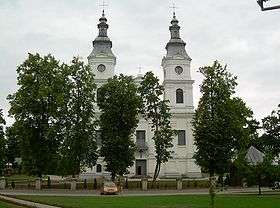
Lithuania has many holy sites, especially in Samogitia, which are worth a visit.
Major pilgrimage sites:
- Gate of Dawn (Vilnius);
- Hill of Crosses, (Samogitia);
- Žemaičių Kalvarija, (Samogitia);
- Šiluva, (Samogitia).
Military heritage
The country has some military sites left and may be very interesting place as a place of militarism heritage tourism. It might be interesting for anyone who is interested in history of the warfare or the Cold War.
Major militarism heritage sites in Lithuania:
- Kaunas Fortress, a massive system of forts built around Kaunas during the Russian Empire rule in the 19th century;
- Former Soviet Nuclear launch site near Žemaičių Kalvarija in Samogitia.[12]
Bicycle tourism

Bicycle tourism is growing, especially in Lithuanian Seaside Cycle Route. EuroVelo routes EV10, EV11, EV13 go through Lithuania. Total length of bicycle tracks amounts to 3769 km (of which 1988 km is asphalt pavement).[13] Most known bicycle routes are: Nemunas River Cycle Route, Suvalkija Cycle Circuit, Lithuanian Seaside Cycle Route. Most of the Tourism information centres and national parks have their local thematic bicycle route plans.
Museums
.jpg)

Museums include:
- Lithuanian Museum of Ethnocosmology
- Palanga Amber Museum
- Vilnius Amber Museum-Gallery[14]
- Palace of the Grand Dukes of Lithuania
- Church Heritage Museum[15]
- Lithuanian Museum of Ancient Beekeeping
- National Gallery of Art[16]
- M. K. Čiurlionis National Art Museum
- Vytautas the Great War Museum
- National Museum of Lithuania
- Vilnius Castle Complex
- Museum of Occupations and Freedom Fights
- Lithuanian Aviation Museum
Gallery

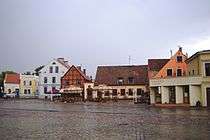
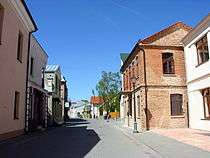
See also
References
- 1 2 "Tourism in Lithuania – 2013" (PDF). Statistics Lithuania. Retrieved 19 August 2014.
- ↑ "Fatbirder. Lithuania". fatbirder.com. Retrieved 5 May 2018.
- ↑ "TOURISM INFORMATION CENTRES". lithuania.travel. Retrieved 25 May 2018.
- ↑ "Visit Lithuania". visitlithuania.net. Retrieved 2 June 2018.
- ↑ "Lithuanian Guides Dtabase". guides.lt. Retrieved 5 May 2018.
- ↑ Number of guests and overnights in Lithuanian accommodation establishments. '000. All markets. 2014–2015
- ↑ Number of guests and overnights in Lithuanian accommodation establishments. '000. All markets. 2015–2016
- ↑ "Lithuanian Sea Museum". muziejus.lt. Retrieved 2 June 2018.
- ↑ "Lithuanian Sea Museum and Dolphinarium". muziejus.lt. Retrieved 2 June 2018.
- ↑ "Hot air balloon becomes name of Game to celebrate Lithuania National Pavilion Day". China Central Television. Retrieved 25 May 2018.
- ↑ "Druskininkai Cable Car". lynukelias.lt. Retrieved 2 June 2018.
- ↑ Žemaitijos nacionalinio parko teritorijoje veikiantys muziejai Archived 8 May 2007 at the Wayback Machine.
- ↑ "The Geography of Tourism of Central and Eastern European Countries". books.google.lt. Retrieved 5 May 2018.
- ↑ "Amber Museum-Gallery". ambergallery.lt. Retrieved 2 June 2018.
- ↑ "Church Heritage Museum". bpmuziejus.lt. Retrieved 2 June 2018.
- ↑ "National Gallery of Art". ndg.lt. Retrieved 2 June 2018.
External links
| Wikivoyage has a travel guide for Lithuania. |
- Lithuanian State Department of Tourism

- Lithuania Travel Guide
- Tourism in Lithuania
- Žemaitija National Park’s website
- Lithuanian Guides Database
_-_cathedral.jpg)

